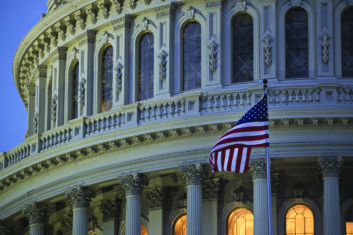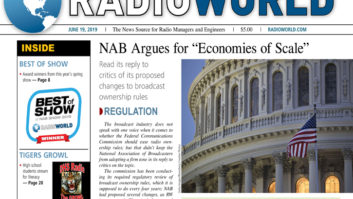
The broadcast industry does not speak with one voice when it comes to whether the Federal Communications Commission should ease radio ownership rules; but that didn’t keep the National Association of Broadcasters from adopting a firm tone in its reply to critics on the topic.
The commission has been conducting its required regulatory review of broadcast ownership rules, which it is supposed to do every four years; NAB had proposed several changes, as RW has reported. They include removal of caps on AM ownership; allowing a single entity to own up to eight commercial FM stations in Nielsen markets 1-75 (or up to 10 FMs for participants in the FCC’s incubator program); and imposing no restrictions on FM ownership in markets 76 and lower and in unrated markets. Critics then weighed in.
In its reply comments, the NAB encapsulated what it views as the main opposing arguments and sought to answer them. Below is the text of its overview section, which NAB prefaced with a tart note giving a definition of “backward” as “in the reverse of the usual or right way.”
The comments submitted by those parties opposing reform of the FCC’s local radio and TV ownership rules are fundamentally backward. Commenters decrying relaxation of the ownership restrictions, for example, argue that the commission, in reviewing its radio rules, would be failing to act in the public interest if it focused on competition among audio delivery platforms for advertising dollars and audiences. To the contrary, that should be the precise focus of the FCC’s review of its radio caps, and commenters such as these have it exactly backward.
[Big Broadcasters Weigh in on Ownership Rules]
If broadcast stations cannot successfully compete against other audio and video delivery platforms for audiences and, thus, advertising dollars, they will not earn revenues needed to cover their substantial fixed costs and will be unable to serve listeners and viewers effectively, let alone improve their programming and technical facilities.
Similarly, other parties insist that broadcast media, especially TV, are critical for providing local communities with news and information, or even for maintaining democracy, but then chastise the FCC for denigrating those values by focusing on economic concerns.
This, again, is backward. The broadcast “industry’s ability to function in the ‘public interest, convenience and necessity’ is fundamentally premised on its economic viability.” These parties fail to explain how imposing ownership restrictions only on local broadcast stations in today’s competitive marketplace promotes their “economic viability” and, thus, their ability to serve the public.
Perhaps most significantly, commenters opposing alteration of the rules interpret Section 202(h) “in the reverse of the usual or right way.” A remarkable number of commenters ignore Section 202(h) entirely, while others selectively cite its terms, leaving out the word “competition.”
These parties urge the FCC to deemphasize competition in its review, contrary to statutory mandate, congressional intent in the 1996 Act, judicial precedent and previous quadrennial review decisions. Particularly given the vastly increased competition in the modern digital marketplace, placing competition at the rear of relevant considerations in this proceeding clearly would be backward.
“INTENSE AND GROWING COMPETITION”
Looking at Section 202(h) in the correct way, the FCC’s primary focus in this proceeding should be on the intense and growing competition radio and TV stations face for audiences and advertising revenue in a broad marketplace with myriad content sources and advertising options.
Due to these profound changes, the current local radio and TV ownership rules are no longer “necessary in the public interest as the result of competition,” and Section 202(h) requires the commission to “repeal or modify” them.
[T]he record here provides more than sufficient information and empirical evidence for the FCC to adopt the National Association of Broadcasters’ proposals.
As multiple commenters, including NAB, demonstrated in comments and studies, radio stations are experiencing declines in audiences due to fierce competition, especially from online options, and significant revenue reductions in local ad markets increasingly dominated by digital platforms. Stations in smaller markets with limited advertising bases especially struggle to generate adequate revenue to cover their fixed costs, and AM stations face special competitive problems in all markets.
If the FCC determines to retain broadcast-only ownership caps, it should permit radio broadcasters to achieve increased economies of scale by (1) removing caps on AM ownership; (2) allowing a single entity to own up to eight commercial FM stations in Nielsen markets 1-75 (with the opportunity to own up to 10 FMs by participating in the FCC’s incubator program); and (3) imposing no restrictions on FM ownership in markets 76 and lower and in unrated markets. NAB’s proposal accurately reflects the competitive environment for local radio broadcasters.
[MMTC One of Many Groups Asking FCC to Disregard NAB Proposal]
The record similarly shows that market competition had led to substantial drops in TV stations’ viewership and advertising revenues and that smaller market stations face special competitive challenges.
Given the scale and concentration of TV stations’ competitors, NAB again urges the FCC to eliminate the per se restrictions that ban combinations among top-four rated stations and that prevent ownership of more than two stations in all markets, regardless of local competitive conditions or stations’ audience or ad revenue shares. Moreover, NAB and other commenters provided analyses of the substantial revenue and ratings gaps between stations ranked in the top four in their local markets that demonstrate the irrationality of the per se ban.
“PROVERBIAL OSTRICHES”
Those parties opposed to reform of the outdated local radio and TV rules present no legal, factual or even logical arguments that undermine NAB’s proposals.
Most notably, these commenters offer no serious analyses — and provide virtually no relevant data — relating to competition for audiences and vital advertising revenues, even though free, over-the-air broadcast stations depend on ad dollars for their very survival.
Perhaps those parties against reform of the rules felt compelled to act as proverbial ostriches with their collective heads in the sand. After all, if they looked at the current market with their eyes open, they would be forced to recognize that radio and TV broadcasters compete against myriad multichannel and online audio and video sources and that the relevant market for evaluating ownership regulations can no longer be limited just to broadcast stations. And in that case, of course, the existing broadcast-only ownership rules would need to be repealed or modified.
But whatever the reason for their failures to meaningfully address the central issues in this proceeding, the FCC should pay little heed to commenters whose submissions opposing reform amount to little more than opinion pieces (or quotes from other people’s opinion pieces).
[Pai Says Yes, Embrace Digital — “But You Are Still Broadcasters First”]
Ironically, retaining the ownership rules unaltered will not promote the professed goals of those opposing any change. Maintaining strict ownership limits has not in the past, and will not in the future, successfully promote diversity of station ownership or programming diversity.
NAB and other commenters firmly believe that addressing the lack of access to capital remains the only effective way to promote new entry into broadcasting. Moreover, retention of the existing rules will not foster, but will instead hinder, the provision of local news programming, given the resources needed to maintain local news operations, especially in smaller markets where stations most struggle to earn advertising revenues to support local programming production.
Finally, it borders on the absurd to contend that broadcast-only restrictions are needed to promote diverse viewpoints in the internet age.
“ECONOMIES OF SCALE”
In reviewing the radio rules specifically, NAB urges the commission to take account of the needs of both AM and FM radio.
While several commenters contend that loosening or removing the FM subcaps will devalue AM stations, no aspects of NAB’s proposal would require, or even directly encourage, radio broadcasters to sell their AM stations, particularly given that AM ownership would no longer “count” against any overall market cap. It also would be inappropriate for the FCC to maintain competitively unnecessary ownership subcaps to essentially coerce broadcasters into acquiring or retaining one type of radio outlet over another.
The appropriate focus here is the ability of the radio station industry overall to compete successfully and serve consumers effectively. As the BIA Radio Study and the detailed comments of numerous radio broadcasters make clear, all radio stations, including FM, need to achieve greater economies of scale.
The FCC should not reject much-needed FM ownership relief, especially in smaller markets, based on speculation about reduced demand for AM stations. That would be the regulatory equivalent of cutting off radio’s nose to spite its face. NAB urges the FCC to foster the success of the AM service in ways other than retaining artificial restrictions on station ownership.
[Groups Press FCC to Recommit to Promoting Media Diversity]
Finally, it is telling that the pay TV industry leads the opposition to reforming the local TV rule. The pay TV interests’ tired complaints about retransmission consent have not improved with age and repetition, and the FCC should disregard their self-serving and factually inaccurate arguments. Rather than ensuring that the viewing public is served by strong local TV stations, pay TV providers’ proposals are designed to weaken their competition for viewers and advertising dollars and gain an even greater advantage in retransmission consent negotiations. Their proposals to make the local TV rule and top-four ban more restrictive at a time when competition in the video marketplace has reached unprecedented levels must be summarily rejected.
In short, NAB urges the commission to rely on the data and empirical evidence submitted in this proceeding about competition in the broader media and advertising markets. Hyperbolic claims that broadcast deregulation will eliminate all diversity and all local news, or generalized complaints about media consolidation, provide no basis for retaining analog-era ownership rules. The FCC should discount the unsupported opinion and rhetoric submitted by parties wedded to a backward-looking approach to regulating radio and TV stations, and adopt rules reflecting competitive conditions in the 21st century.
To read the NAB’s 90-page filing, go to https:// tinyurl.com/rw-nab-ownership. To read other comments filed to the FCC, visit https://www.fcc.gov/ecfs/ and search MB Docket 18-349.












